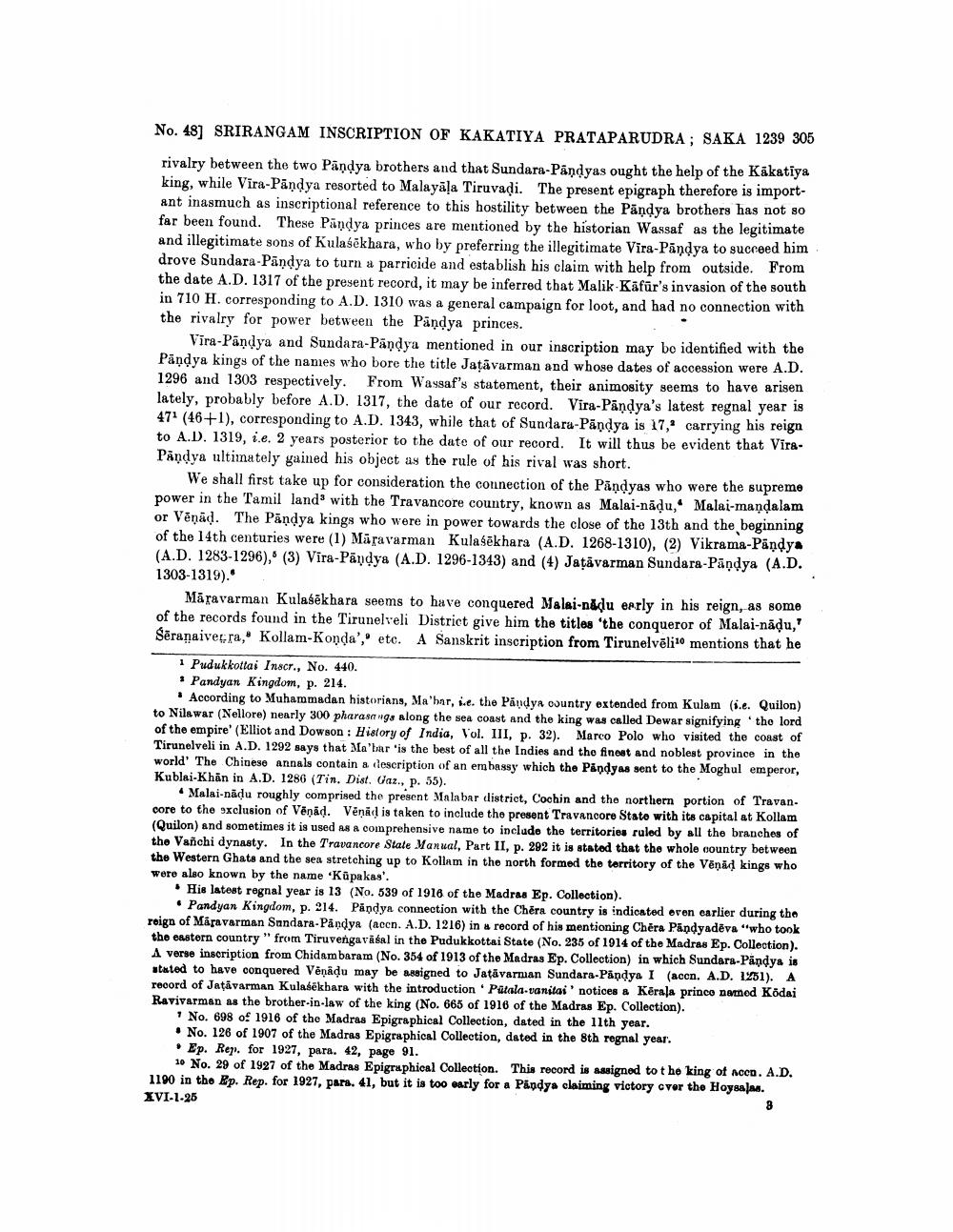________________
No. 48) SRIRANGAM INSCRIPTION OF KAKATIYA PRATAPARUDRA; SAKA 1239 305
rivalry between the two Pandya brothers and that Sundara-Pandyas ought the help of the Kakatiya king, while Vira-Pandya resorted to Malayāļa Tiruvadi. The present epigraph therefore is important inasmuch as inscriptional reference to this hostility between the Pandya brothers has not so far been found. These Pandya princes are mentioned by the historian Wassaf as the legitimate and illegitimate sons of Kulasekhara, who by preferring the illegitimate Vira-Pandya to succeed him drove Sundara-Pandya to turn a parricide and establish his claim with help from outside. From the date A.D. 1317 of the present record, it may be inferred that Malik-Käfür's invasion of the south in 710 H. corresponding to A.D. 1310 was a general campaign for loot, and had no connection with the rivalry for power between the Pandya princes.
Vira-Pandya and Sundara-Pandya mentioned in our inscription may be identified with the Pandya kings of the names who bore the title Jaţăvarman and whose dates of accession were A.D. 1296 and 1303 respectively. From Wasgaf's statement, their animosity seems to have arisen lately, probably before A.D. 1317, the date of our record. Vira-Pandya's latest regnal year is 471 (46+1), corresponding to A.D. 1343, while that of Sundaru-Pandya is 17,9 carrying his reign to A.D. 1319, i.e. 2 years posterior to the date of our record. It will thus be evident that ViraPandya ultimately gained his object as the rule of his rival was short.
We shall first take up for consideration the connection of the Pandyas who were the supreme power in the Tamil land with the Travancore country, known as Malai-nādu, Malai-mandalam or Vēņād. The Pandya kings who were in power towards the close of the 13th and the beginning of the 14th centuries were (1) Märavarman Kulasēkhara (A.D. 1268-1310), (2) Vikrama-Pandya (A.D. 1283-1296), (3) Vira-Päydya (A.D. 1296-1343) and (4) Jatavarman Sundara-Pandya (A.D. 1303-1319).
Māravarman Kulasēkhara seems to have conquered Malai-nádu errly in his reign, as some of the records found in the Tirunelveli District give him the titles 'the conqueror of Malai-nādu,' Sēranaivecra, Kollam-Konda', etc. A Sanskrit inscription from Tirunelvēlio mentions that he
· Pudukkottai Inscr., No. 440. * Pandyan Kingdom, p. 214.
According to Muhammadan historians, Ma'har, i.e. the Pandya country extended from Kulam (.e. Quilon) to Nilewar (Nellore) nearly 300 pharasegs along the sea coast and the king was called Dewar signifying the lord of the empire' (Elliot and Dowson : History of India, Vol. III, p. 32). Marco Polo who visited the coast of Tirunelveli in A.D. 1292 says that Mo'bar'is the best of all the Indies and the finest and noblest province in the world' The Chinese Annals contain a description of an embassy which the Pandyas sent to the Moghul emperor, Kublai Khan in A.D. 1286 (Tin. Dist. Gaz., p. 55).
Malai-nādu roughly comprised the present Malabar district, Cochin and the northern portion of Travan. oore to the exclusion of Vēnad. Vēņåd is taken to include the present Travancore Stato with its capital at Kollam (Quilon) and sometimes it is used as a comprehensive name to include the territories ruled by all the branches of the Vañchi dynasty. In the Travancore State Manual, Part II, p. 292 it is stated that the whole country between the Western Ghats and the sea stretching up to Kollam in the north formed the territory of the Vēņád kings who were also known by the name 'Kapakas'.
His latest regnal year is 13 (No. 539 of 1916 of the Madras Ep. Collection).
• Pandyan Kingdom, p. 214. Pandya connection with the Chera country is indicated oven earlier during the roign of Maravarman Sandara-Påndys (accn. A.D. 1216) in a record of his mentioning Chéra Pandyadēva "who took the eastern country" from Tiruvengavāśal in the Pudukkottai State (No. 235 of 1914 of the Madras Ep. Collection). A verse inscription from Chidambaram (No. 354 of 1913 of the Madras Ep. Collection) in which Sundara-Pandya is atuted to have conquered Venadu may be assigned to Jatavarman Sundara Pandya I (accn. A.D. 1251). A record of Jatavarman Kulasēkbara with the introduction Pülala-vanitai' notices & Kerala prince named Ködai Ravivarman as the brother-in-law of the king (No. 665 of 1916 of the Madras Ep. Collection).
* No. 698 of 1916 of the Madras Epigraphical Collection, dated in the 11th year.
No. 126 of 1907 of the Madras Epigraphical Collection, dated in the 8th regnal year. • Ep. Rep. for 1927, para. 42, page 91.
10 No. 29 of 1927 of the Madras Epigraphical Collection. This record is signed to the king of scen. A.D. 1190 in the Rp. Rep. for 1927, pars. 41, but it is too early for a Påndya claiming victory over the Hoysales. XVI-1-25




